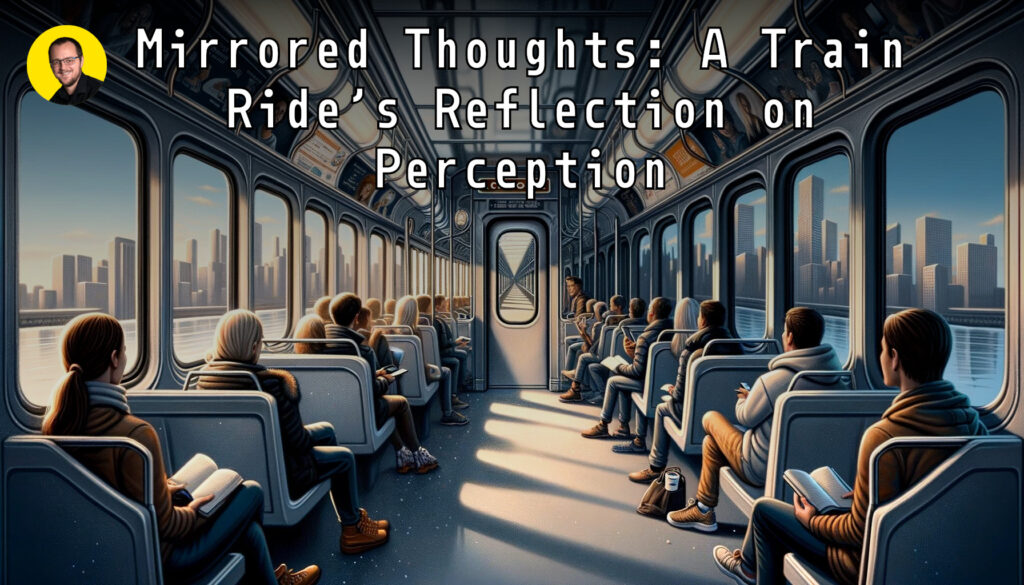
In my book Method Matters, I dedicate a chapter to introducing ways of thinking creatively and outside-the-box. One of the primary creative thinking techniques I discuss is thought experiments. A thought experiment is a mental tool that you use to explore a hypothesis by setting up a situation, then imaging how the situation plays out in relation to your hypothesis with the goal of determining if the hypothesis is correct, incorrect, or partially correct. Thought experiments have a wide array of applications, including areas of study, such as philosophy and science, as well as every-day tasks, such as optimizing your routine or planning out a project.
One of the example thought experiments in my book involves mirrors. After I finished writing the book, I had an interesting experience one day on the train during my commute back from Manhattan that involved reflective surfaces, so I’d like to share this in the form of a different thought experiment relating to mirrors.
People often say that mirrors invert left and right. Let’s construct a thought experiment to see if this is true. Imagine that you’re on a train that has just started to leave the station. You can feel the acceleration, so you know that you are moving by feeling alone. However, once the train stops accelerating, that feeling of acceleration will stop, so the only way you’ll know that you’re moving is by looking out a window (assume that you can’t tell by other sounds or hints).
Now let’s say that train is overcrowded. There are no more seats available and the aisles are crowded, so the only spot remaining is a spot to stand right in front of the cab’s door. You walk there and have to stand in such a way that you are looking at the door. The glass on the door is reflective, so you can see a reflection of windows from both sides and see outside. We’ll refer to this as the mirror below. The train starts moving forward, and the door you are facing is closer to the front, so you are also looking forward.
Now, let’s test the original hypothesis, that mirrors invert left and right, with two questions:
- If you see a Chipotle store on the left side of the mirror, where is that store in relation to the train?
- In that mirror, does it appear that the train is moving forwards or backwards?
Let’s consider those questions. To answer the first question, consider a simpler example: you are on a train where only one side has windows. Now, if the windows are on the left side of the mirror, raise your left and and point left. If they’re on the right side, raise your right hand and point right. In either case, your left or right hand will be correctly pointing to the windows, so if you turn your head to look away from the mirror and at your hand, you’ll also see the windows. Back to the original setup, if you were to point to the Chipotle with your left hand, that would mean it is on the left side of the train and slightly behind you. This is proof that mirrors do not invert left and right, and we found this proof using a thought experiment that is at least partially based on your own past experiences (if you never saw a mirror before, you might have had more trouble answering this question).
To answer the second question, keep in mind that everything you’re seeing in the mirror is behind you. As the train moves forward, the distance between you and the things you are seeing will increase and therefore appear to get smaller within your field of vision. This corresponds to the effect that would take place if you were to walk backwards for some time. Therefore, it would appear that the train is actually moving backwards based solely on the mirror reflection. This shows that mirrors do invert forward and backward.
With this thought experiment, we’ve both determined that mirrors do not invert left and right, and that they do invert forward and backward. The thought experiment laid out in my book is simpler than this one, but this one was based on a recent experience of mine, so I thought it would be worth sharing.
The inspiration of this thought experiment was the experience on the train I had recently: I was in a crowded train standing in-front of a door, similar to the setup above. I had a few stops before I would disembark, so I found myself either looking at my phone or letting my mind wander. At one point, after thinking about something for some time, I looked at the door’s reflection and saw that the reflection made it seem the train was moving backward. For a fraction of a second, I seemed to have unconsciously thought it was, then unconsciously corrected myself, so it was a small but strange experience, similar to correcting your orientation.

By Quinn, Brandon (Paperback)